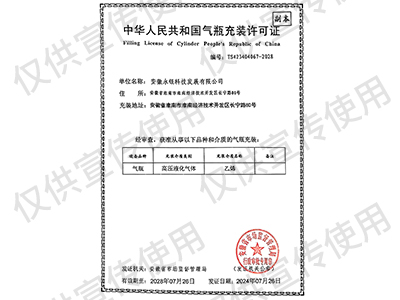Knowledge of gases
Ethylene Hazards and Usage Precautions
I.Special Warning
Ethylene is an extremely flammable gas with strong anesthetic properties.
Under fire conditions,it can undergo dangerous polymerization reactions.
II.Physical and Chemical Properties
Ethylene is a colorless gas with a sweet odor.
It is insoluble in water,slightly soluble in alcohol,and soluble in ether,acetone,and benzene.
Molecular weight:28.05
Melting point:-169.4°C
Boiling point:-103.9°C
Gas density:1.260 g/L
Specific gravity:(water=1)0.61
Relative vapor density(air=1):0.98
Critical pressure:5.04 MPa
Critical temperature:9.2°C
Saturated vapor pressure:8100 kPa(at 15°C)
Explosive limits:2.7%to 36.0%(by volume)
Ignition temperature:425°C
Minimum ignition energy:0.096 mJ.
III.Hazard Information
Flammability and Explosion Risk
Ethylene is highly flammable;mixing with air can form explosive mixtures.
There is a risk of combustion and explosion when exposed to open flames,high heat,or oxidizers.
Reactive Properties
Ethylene reacts violently with fluorine,chlorine,etc.
Health Hazards
Ethylene has strong anesthetic effects.
Acute poisoning:Inhalation of high concentrations can cause immediate loss of consciousness;liquid ethylene can cause frostbite.
Chronic effects:Long-term exposure may lead to dizziness,general discomfort,weakness,and impaired concentration.
IV.Safety Measures
General Requirements
Personnel must receive specialized training,follow operating procedures,master operational skills,and understand emergency response knowledge.
Ensure airtight operation,prevent leaks,and maintain comprehensive ventilation in workplaces.
Install leak detection alarms in production,usage,and storage areas.Use explosion-proof ventilation systems and equipment.Keep away from sources of ignition and heat.Prohibit smoking in the workplace.Wear anti-static clothing.
Pressure vessels and equipment should be equipped with safety valves,pressure gauges,level indicators,thermometers,and safety devices with remote monitoring and alarm functions.Install emergency shutdown devices on input/output pipelines.
Avoid contact with oxidizers and halogens.
Set up safety warning signs in production and storage areas.Handle containers carefully to avoid damage.Ground and bond cylinders and containers during transfer.Equip appropriate fire-fighting equipment and leakage emergency response devices.
Special Requirements
Operation Safety
Regularly measure and announce ethylene concentrations at work sites.
No open flames or potential ignition sources in production areas(fixed flame zones must be over 30 meters from production areas).Obtain approval for hot work permits when necessary.Use nitrogen purging before maintenance or repairs on ethylene equipment,containers,and pipelines.
Do not thaw frozen pipelines,valves,or water seals with open flames;use hot water or steam instead.
During operation,do not strike,repair under pressure,or operate under vacuum conditions.
Use swivel pipe filling systems during loading to prevent overfilling.
V.Emergency Response Principles
First Aid Measures
Inhalation:Move to fresh air immediately.Maintain airway patency.Administer oxygen if breathing is difficult.Perform artificial respiration if breathing stops.Seek medical attention.
Skin Contact:For freeze burns,immerse affected area in warm water(38-42°C).Do not rub.Do not use hot water or radiant heat.Cover with clean,dry dressing.Seek medical attention if discomfort persists.
Firefighting Methods
Shut off gas supply.If supply cannot be cut off,do not extinguish the flame at the leak site.Cool containers with water spray and move them to an open area if possible.
Suitable extinguishing agents include fog spray,foam,carbon dioxide,and dry powder.
Leakage Emergency Response
Eliminate all ignition sources.Establish exclusion zones based on gas dispersion.Evacuate non-essential personnel to safe areas.Responders should wear positive pressure self-contained breathing apparatus and anti-static clothing.Ground all equipment used.Prevent skin contact with liquid.Do not touch or cross over spill.Shut off source if possible.Turn container to vent gas rather than liquid.Use fog spray to suppress vapor or redirect vapor cloud.Do not use direct water spray on the spill.Prevent gas from entering sewers,ventilation systems,or confined spaces.Isolate spill area until gas dissipates.
As a precaution,set an initial isolation distance of at least 100 meters for minor leaks.For large leaks,the downwind evacuation distance should be at least 800 meters.





